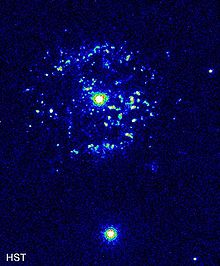Nova remnant

A nova remnant is made up of the material either left behind by a sudden explosive fusion eruption by classical novae, or from multiple ejections by recurrent novae. Over their short lifetimes, nova shells show expansion velocities of around 1000 km/s,[1] whose faint nebulosities are usually illuminated by their progenitor stars via light echos as observed with the spherical shell[1] of Nova Persei 1901[2] or the energies remaining in the expanding bubbles like T Pyxidis.[3]
Form

Most novae require a close binary system, with a white dwarf and a main sequence, sub-giant, or red giant star, or the merging of two red dwarfs, so probably all nova remnants must be associated with binaries.[4] This theoretically means these nebula shapes might be affected by their central progenitor stars and the amount of matter ejected by novae.[1] The shapes of these nova nebulae are of much interest to modern astrophysicists.[1][4]
Nova remnants when compared to
See also
References
- ^ .
- Bibcode:2014ASPC..490..109L.
- S2CID 3047485. Archived from the originalon 5 January 2013.
- ^ .
External links
- "T Pyxidis". Hubble Site. Nova Remnant. 1997.
- "Double-star systems cycle between big and small blasts". The Carnegie Observatories. Archived from the original on 8 August 2008.
- "Nova Remnant comparison table". U. Ottawa. Archived from the original on 5 July 2006.
- "Nova Remnant". U. Ottawa. Archived from the original on 5 July 2006.
